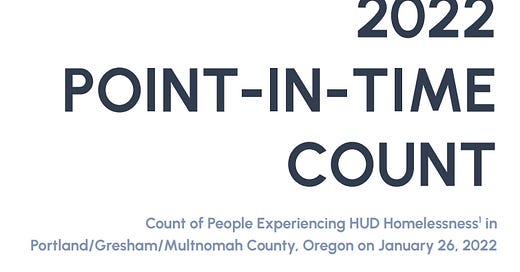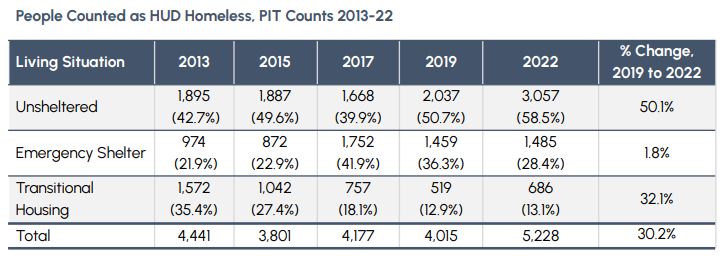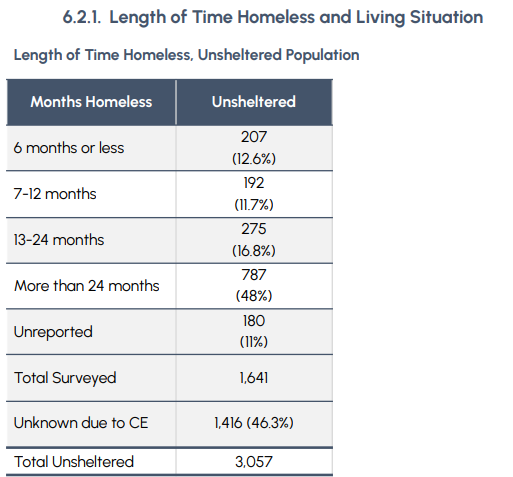In case you missed it: the Multnomah County Point-In-Time Count was published just days after the election
Let's look at discrepancies between what Multnomah County claimed would be in the report, and what was actually there.
Originally scheduled to be published "later this summer" for some unknown reason the report was delayed and delayed.
Well, you can read it here:
Full Report: https://www.multco.us/file/124083/download
Mirrored Full Report: https://multco-web7-psh-files-usw2.s3-us-west-2.amazonaws.com/s3fs-public/2022%20Point%20In%20Time%20Report%20-%20Full.pdf
What's in the new report?
First we ought to ask, what did they omit from the previous reporting in May that's now in the full report? No surprise the reporting in May focused on "disproportionate impact on BIPOC communities" and to be sensitive to "culturally specific" considerations - but it was incredibly light on numbers, no data when it comes to trends, but big on pandering and promises.
The new report calls out immediately:
Homeless increased 30.2% during
the pandemicthe last two years.Primarily driven by an increase in people identified as "unsheltered."
Chronic homelessness number is up 50% ("chronic homeless" means homeless more than year, but there's a lot of disclaimers that come along with this)
Of those who did come to Multnomah County while already experiencing homelessness, 60% are NOT from the metropolitan region or the rest of the state of Oregon.
Now....I might be.... a bit biased.
I highly encourage you to read yourself. Inform yourself about this issue if you actually care about it.
The Point-In-Time Count has always been a bunch of politically correct garbage, but this time around they actually acknowledged it's garbage which is truly amazing! In previous years they pretended the study was this sacrosanct scientific process, unquestionably the best source of data. In reality, a 10th grade kid in PPS's statistician class would see right through this garbage methodology - primarily the biggest problem is that the number of homeless they count is based only upon the number of volunteers they have. This report is clever enough to include those numbers: 312 volunteers signed up, 192 actually attended the training, and 112 people volunteers showed up for 139 volunteering shifts in the 37 various outreach zones. It's also noted that the PSU volunteer base "the stress and fatigue were palpable" so it may not have been the best workers, plus the "agencies" are detailed on page 96 and there's a shitload of variance yr/yr (see image below), like some organizations that participated in 2017 & 2019 just didn't participate in 2022. Again, these numbers are all just steaming bullshit, but the county claims to use these numbers to pretend they understand they know what they're on about.
the report doesn’t account for this yr/yr variance - but there’s probably an interesting story here
But OK - what's NOT in this report?
Well first is the self-flagellating "disproportionate impact" that they said would be in here, in fact this full article notes "Racial disparities grew somewhat." "Somewhat" doesn't read like a full-blown racial crisis. In fact the article notes 34.3% of the Multnomah County population identifies as BIPOC, and they represent 38.9% of the homeless population. That doesn't read to me as insane levels of over-representation or even necessitating a moral panic. For example, 7.1% of Multnomah County's population identify as "Black or African American" and 16.2% of homeless identify as Black or African American. If that proportion legitimately deserves a moral panic call out and a lot of attention, it's worth noting that just 4% of Multnomah County are military veterans, yet 10.5% of homeless people identify as veterans according to this report. Happy Veterans Day! I have some "culturally specific" advice for Jessica Vega Pederson, but I'll leave that for another time. If any of you feel generous enough to "help homeless veterans" on Veterans Day, I recommend donating to Fort Kennedy in Clackamas.
The report DESPERATELY tries to blame all of this on COVID-19 and yet, "nearly a quarter (24%) affirmatively said COVID-19 was a reason they were living on the street." And we're taking this 25% of people at their word? Seriously? Is there any fucking evidence that their claims or perceptions are accurate? Do we know if the people who answered "affirmative" were sober? No. No. No. And the highest rate of people reporting that COVID made them homeless was in the unsheltered population 27.1% compared to the "traditional housing" homeless at just 11.3%. But don't worry, the report did talk about Omicron 8 fucking times. And here's a fun fact: they asked the homeless about vaccination status (see pg 100, question 15), yet that information isn't in the report....hmm. Does the restaurant Andina know their vaccination policy discriminates against the houseless? Someone ought to really submit a FOIA request on that data on vaccination rates, cause that might be absurdly embarrassing.
There are some takeaways - some insights that are constantly controversial - especially about What's up with homeless people moving here? Does that happen? How many? Why do they come!?!
Spoilers: there's no category for "drugs" or "I'm a sex offender and wanted to slip off the radar" - but there are some compelling charts on Page 70 about "migration" - it's important to note that the MAJORITY of homeless people surveyed didn't answer this (i.e., the total survey counted 5,228 respondents, far less answered questions about their background).
Only ~20% of homeless responded that they're "I'm from here originally." (n=5,228) Before you get too high and mighty about this, remember that more than 80% of you fucking people reading this ain't from here, either. Put your pitchfork away if you didn't play baseball at Alpenrose as a kid, ok?
Of all people interviewed about current housing status (n=1,798), 50.6% claim to not be homeless upon arrival, 45.3% claimed they were homeless on arrival.
The report then splices this data into people who are chronically homeless (n=1,224) and those who have been homeless less than 2 years (n=576). If you see an homeless guy who looks "chronically homeless" there's a 31% chance that guy arrived here homeless, and a 56.8% chance they arrived here NOT homeless, and an 11.3% they won't answer (without being bribed with a space whip). Meanwhile, a new homeless person living unsheltered, there's a 67.6% chance they arrived here homeless, a 29% chance they arrived here with a house, and a 3% chance they don't answer that question.
Where do these people come from? Of the unsheltered homeless NOT from Multnomah County, 19% come from Clackamas, Washington, or Clark County, 15% come from outside the Portland Metro area but still in Oregon (in other words 34.4% are Oregonians). 27.2% come from California or Washington - and 32% come here from elsewhere.
"Reason for Migrating" to Multnomah County is listed on page 77. Well, sort of, about 25% of respondents (n=815) "unreported" to that question - presumably because their answer wasn't fit for print and had a check box. Does "Sell drugs" mean "jobs?" I dunno. Of the unsheltered homeless: 22% moved here for "access to services or resources", 37.5% family/friends, 15% jobs, 12.2% like it here/good weather (hahaha!). There's not significant differences between Chronic and New homeless in these results.
Another great question is "How long have unsheltered people typically been homeless?" Page 63 tries to address this, but nearly half of the respondents didn't give enough information. Of those that gave information, 12.6% 6 months or less, 11.7% 7-12 months, 16.8% 13-24 months, and 48% more than 24 months. In other words, it's fare to guess that if you see a unsheltered homeless person, it's 50/50 chance they've been on the street for 2 years.
There's a handful of things that Multnomah County has focused on to pursue it's quixotic desire to make all things woke.
For example, you could speculate given the news coverage that there's a huge problem of transgender homeless. But nah, only 80 of them were found in all the entire count. A further 99 individuals identified as "a gender that is not singularly female or male" and 13 claimed "questioning." All told, that's 192 individuals out of 5,228, or 3%. I'd bet $1 there's more sexual/gender diversity in a Beaverton middle school these days.
In a similar sense, the number of unsheltered self-identified black folks increased from 276 in 2019 to 431 in 2022. That's undeniably a big jump - but the questions as to why this might be the case.... you can imagine... the report doesn't explore answers or ideas, instead it repeats the dogma of the day. There was also a big jump in the number of people who didn't respond to race/ethnicity questions - going from 99 individuals in 2019 to 227 in 2022. Could the zeitgeist focused on race and treating races differently also cause some people to answer this question differently? I suppose that's beyond the merits of this study. Either way, the study makes sure to note: "This data further emphasizes the importance of prevention and housing placement strategies that are designed to meet the specific challenges faced by communities of color experiencing growing disparities in their rates of homelessness." In other words, "Make sure we treat people differently based upon the color of their skin!"
It's also worth noting there was a few nitpicky formatting and typo errors. Let's just say the delay in releasing this report had fuck all to do with delays from the Editor, believe that.
A few notes after publication:
I totally saw this coming - over on Reddit I saw a post 15 days ago asking “where’s the detailed Point In Time Count” from Multnomah County? I accurately declared “Waiting until after the elections, obviously.”
Is it a conspiracy that publication was delayed? Probably. If you ask Cui Bono? it’s pretty obvious that it’s Vega Pederson and Kotek, two people who would be able to influence delaying a publication like this - cause delaying the report directly helps you ensure your future boss gets elected. And at least with Kotek, she’s got a lucky streak going with delayed publications. It has dawned on me that Stoel Rives delaying the release of this Hernandez report is a quid-pro-quo if I’ve ever known one - and the easiest “above board” way to delay the report would be for Kotek’s staff to instruct Stoel Rives “Don’t turn over this report until our invoice is paid.” Not a single goddamn journalist is going to ask skeptical questions about this, but man, imagine the sweet irony if detailed are released early next year by someone like Nate Monson about the Hernandez case that causes Kotek to resign like Kitzhaber. Hopefully our Secretary of State pulls out her knives on Kotek, cause that’s the only way she’s leaving office in the next 8 years.
It’s also worth understanding how local media in Portland spun and buried the Point In Time Count story. In an age where most people only read the headlines, let’s review:
The Oregonian: “COVID helped fuel rise in Portland homelessness”
Tribune: “Pandemic increased homeless count in Multnomah County”
KATU: “This year, Multnomah County's 'Point in Time Count' assesses COVID impact”
KPTV: “Multnomah County report reveals COVID-19′s impact on homelessness”
This is exactly why I’ve maintained independent status as a journalist and why I’m so thankful for Substack. The media outlets in this town are not wiling to do any actual analysis or go against the grain on the messaging.
And again, there’s no fucking evidence COVID had a lick to do with the homeless besides self-reported surveys. And let’s be honest here, these are not reliable people being surveyed. Especially as witnessed by unwillingness to answer some questions about their background en masse. No doubt some marginal number of people had increased financial difficulties due to layoffs and corporate uncertainty, but in my assessment the economic catastrophe we’re experiencing today in Portland (such as a dead downtown) was simply accelerated due to COVID, and the underlying problems were already in the works.
If you’d like to learn more about COVID and homelessness, “The Impact of the COVID-19 Pandemic on Homelessness in the United States” by United Way of the National Capital Area has some data. And there’s shitloads of ivory tower academics opining in journals about it - with a common trend being “financial stimulus plans aimed at easing COVID burdens didn’t target the homeless very well.” Which I can only think, yeah, no shit - this wasn’t supposed to be a free money program, but a stimulus of our economy. Homeless folks didn’t get a fair share of PPP loans, damn you Donald Trump!
But isn’t that the perfect story of COVID? A person (or in our case, the city/society) died while COVID was happening so the government attributes that death to COVID - died in motorcycle crash while having COVID? Well that’s a “died from COVID!” And in every capacity, putting everything on COVID enables government to declare “not our fault at all!” Now that the mid-terms are over, I wonder how many politicos will go back to fear mongering COVID? Don’t forget your Boosters folks, or it’s the Winter of Death for ya’. Hopefully, 10 years from now, we can still blame all of the political incompetence on COVID-19.








